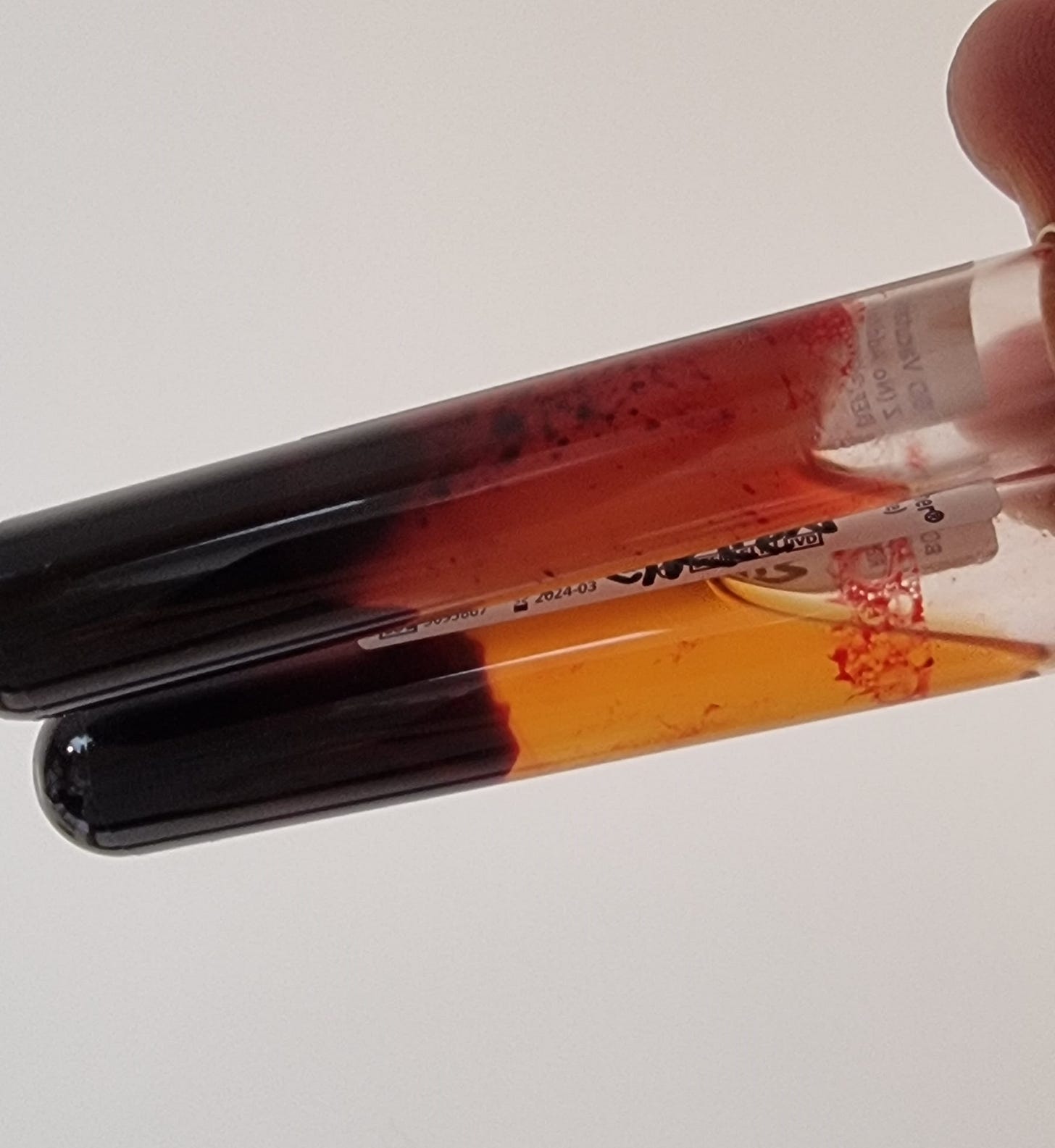Below, blood spins before, and after 20 minutes of sublingual green laser. Top is the before with the polymer, bottom is after laser, looking like our serum should. This is repeatable for the vast majority.
I have previously posted videos of the orange gobblers or gel bubbles swallowing our healthy blood cells. Below is 2 random examples of what they look like on a slide when there is a heavy concentration of the gel in the blood. A 90 % reduction that is enough to then get clean serum as above. I don’t need to do a blood spin to know what I am seeing.
We do both a drop and a smear when taking a sample. These gobblers show up mostly in the smear as below. For heavy gel content you don’t even need a microscope. I have previously posted a before and after of what the blood looks like pre / post laser and we have tons of similar examples on record now. Every single person has been happy to see the state of their blood after, less rouleaux, fatter RBC’s, more spacing and happy active neutrophils. We always compare best blood pre with best blood post, using the same methodology.
My take is that these bubbles form after a smear due to a sudden drop in temperature (as per Ronald Norris’s good works) combined with the turbulence created during the smear. They are a great indicator of the level of polymer in the blood. When the slides are tilted back and forth to reflect a light source you can also see a faint oil rainbow with high polymer content.
This example shows that this could even be a home test to do without a scope - just with slides, slips and 2 drops of blood. Very minor bubbles would be visible with a magnifying glass or those $20 skin scopes. The blood is smeared holding the cover slip at approximately 30 degrees and applying a very gentle pressure for about 3/4 of the distance / size of the slip and then the slip is moved back to the start and dropped on it. With severe polymer content sometimes you will need to gently tap the slip to get it to attach at both ends.
The laser we are using is a medical class 3b cold laser at 532 nm wavelength and we are inputting a frequency into the laser of 528 for both IV or sublingual.
528 = Mi, the frequency of bees, chlorophyll, the sun, heals and restores dna, gives the red blood cells a 20% increase in life expectancy - all according to research done.
While the in series blue and green IV kept the blood good for nearly a month, using that combo side by side sublingually didn’t work. Other things that can effect the results are combining other products. We also tried taking other products simultaneously to see if we could improve the process and will continue experimenting. These results are still experimental but we have seen an improvement of the blood every time so far with just the laser - probably well over 100 times now.
Believe it or not, that’s your call.
Next on the hit list, Bluey and the bots.
“Experience is something you don’t get until just after you need it.”
~~ Stephen Wright ( Thanks J Lee for the pinch )
…………………………………………………………………….
Below - A comment that I lifted as I liked the analogy and thought it applicable here
………………
credit-
I know some very clever people who won't even entertain the idea. I liken it to the "can't find the sugar" syndrome, where you look in a cupboard for a bag of sugar and can't see it. Then the spouse comes in and finds it instantly. The bag of sugar was in a green pack, but you were looking for a red pack. You had mind filters working against you. So often, those who are highly educated won't even go and look for the sugar, because they've been told that it is not there, and their prized education has put a more all-encompassing filter on their minds.
How does one break through those filters?
(How Indeed? m)








My Green 532nm laser saved my life.
I'm glad it's helping others.
Woohoo.
Winning.
Hi Matt great start. Did you get any blood showing the denser gel plastic as we previously saw in Auckland? If so does it resolve? I would be really keen to see more photos of these comparisons. Could you please provide some links to the research using the smears to quantify the amount of polymer in the blood as I am not familiar with this work. What are the appearances under darkfield? Lastly, I would be keen to see some quantifiable results across the 100 patients if possible as clearly this is important work that requires a larger dataset. I look forward to seeing more!